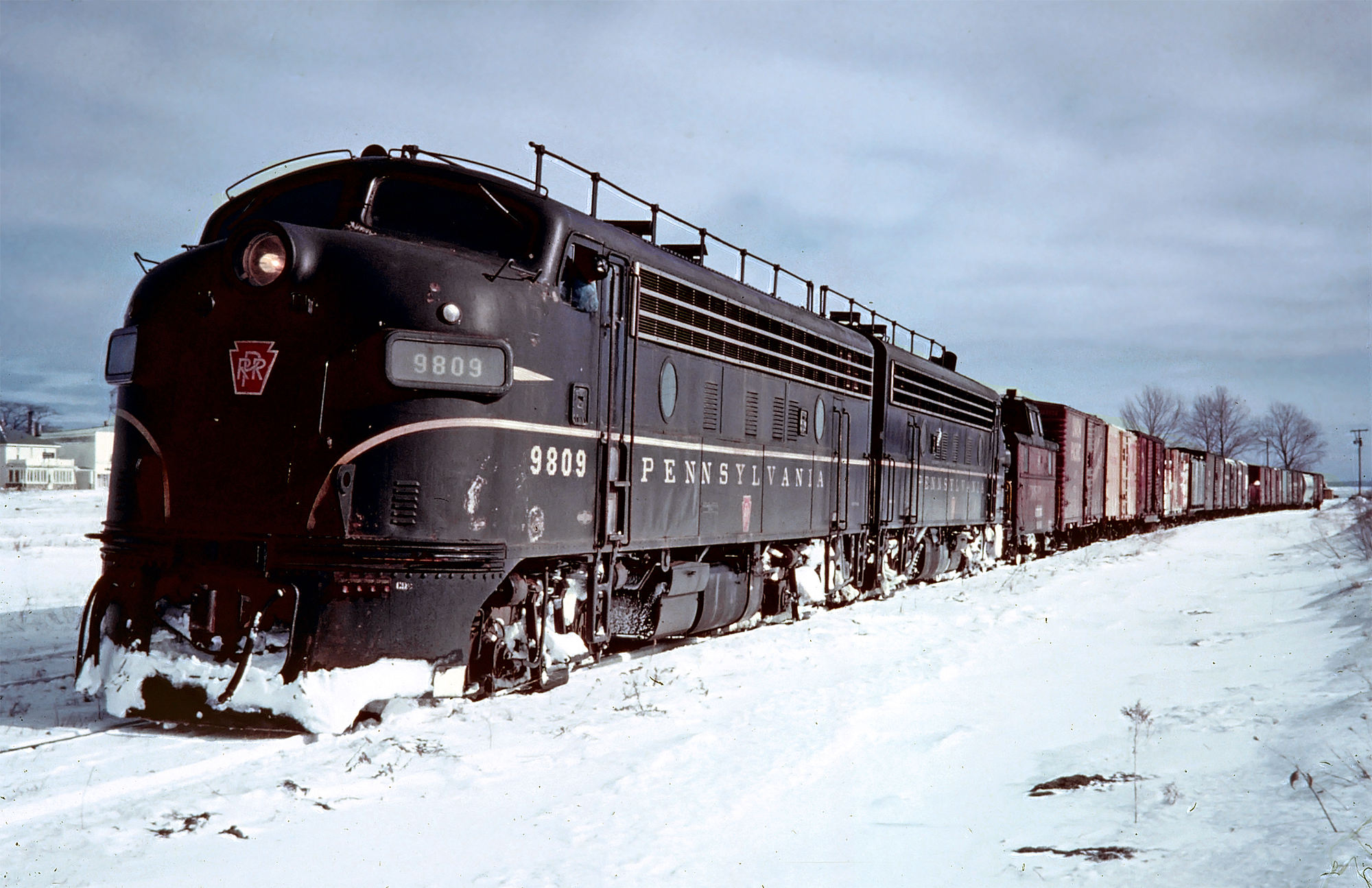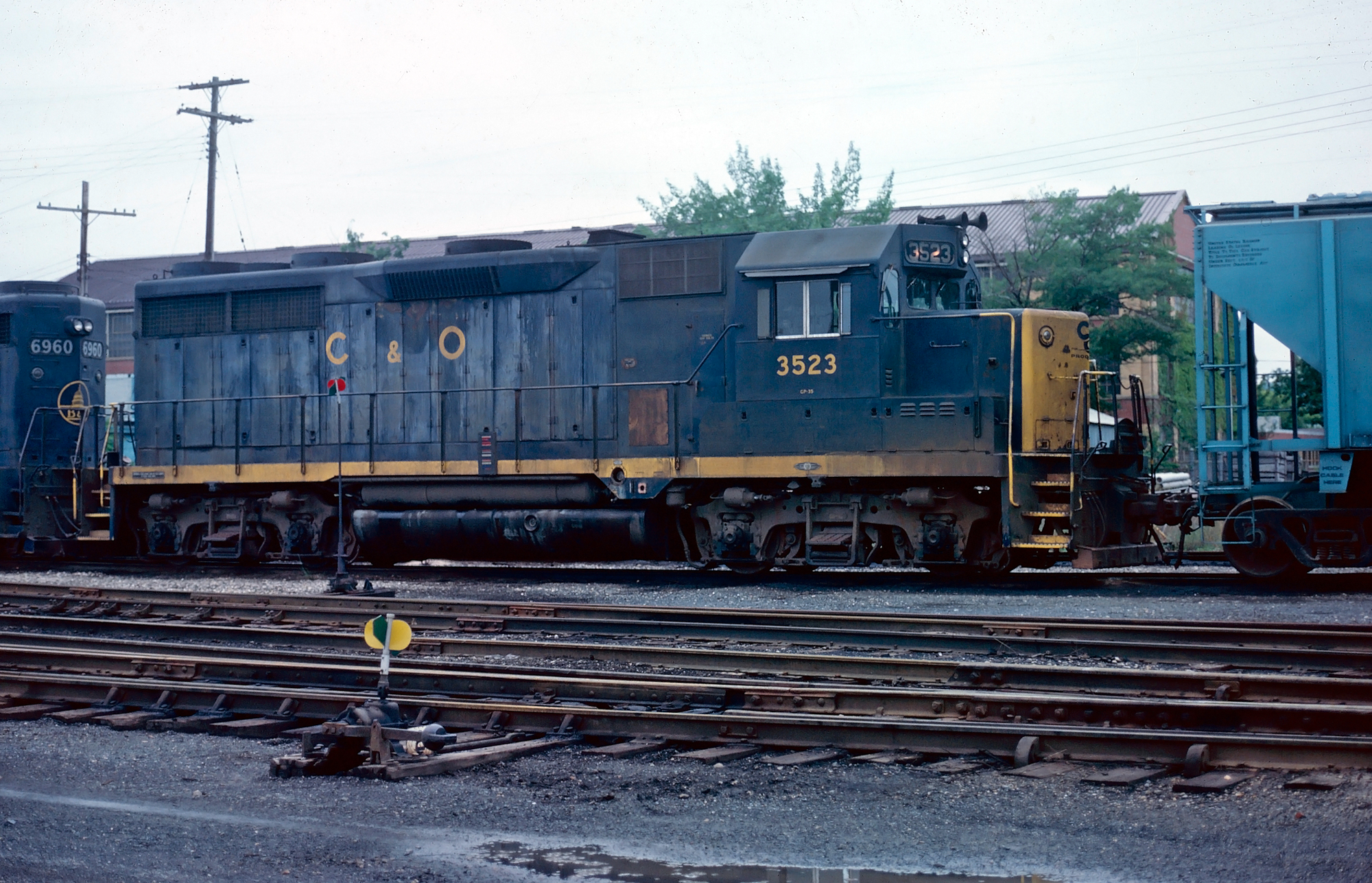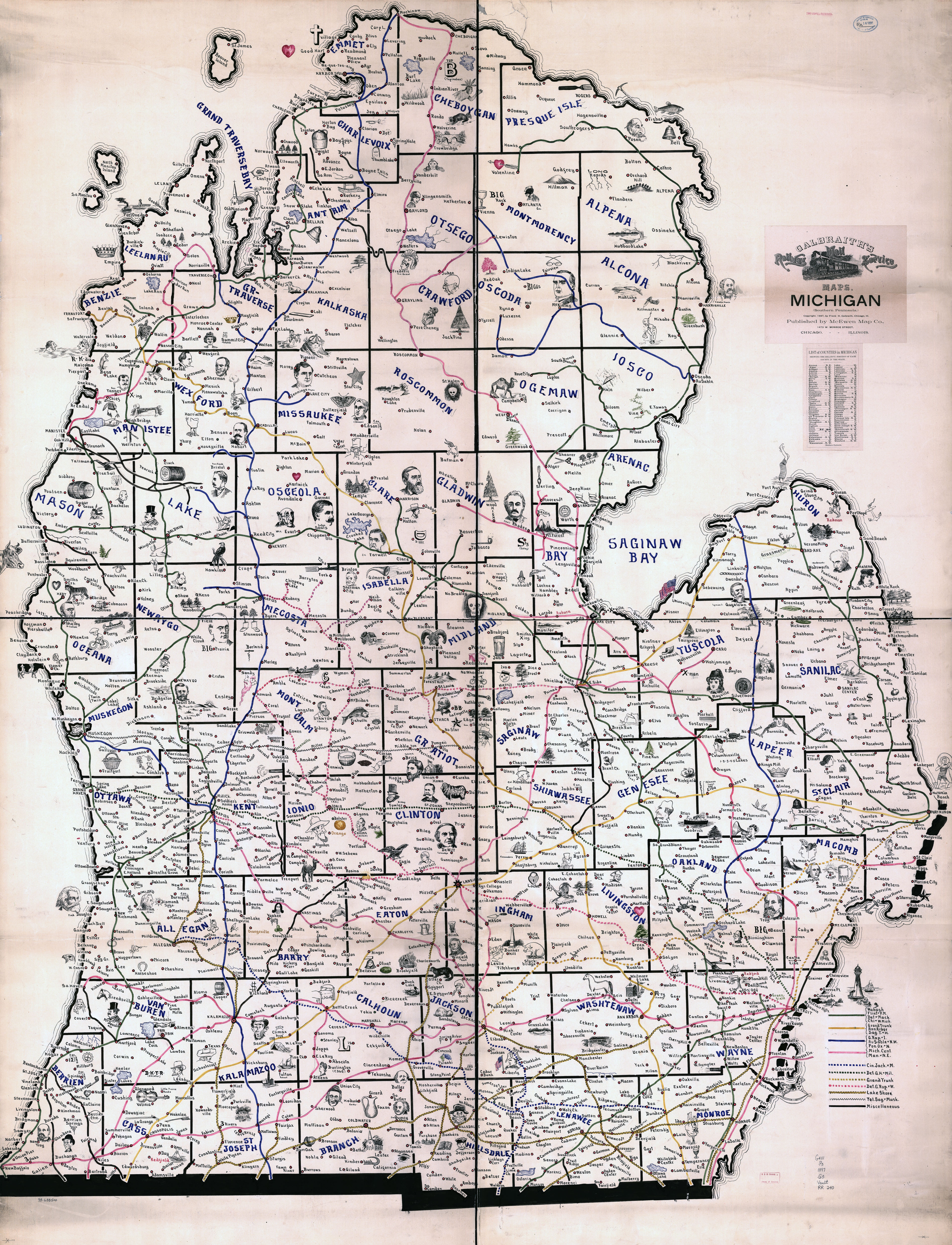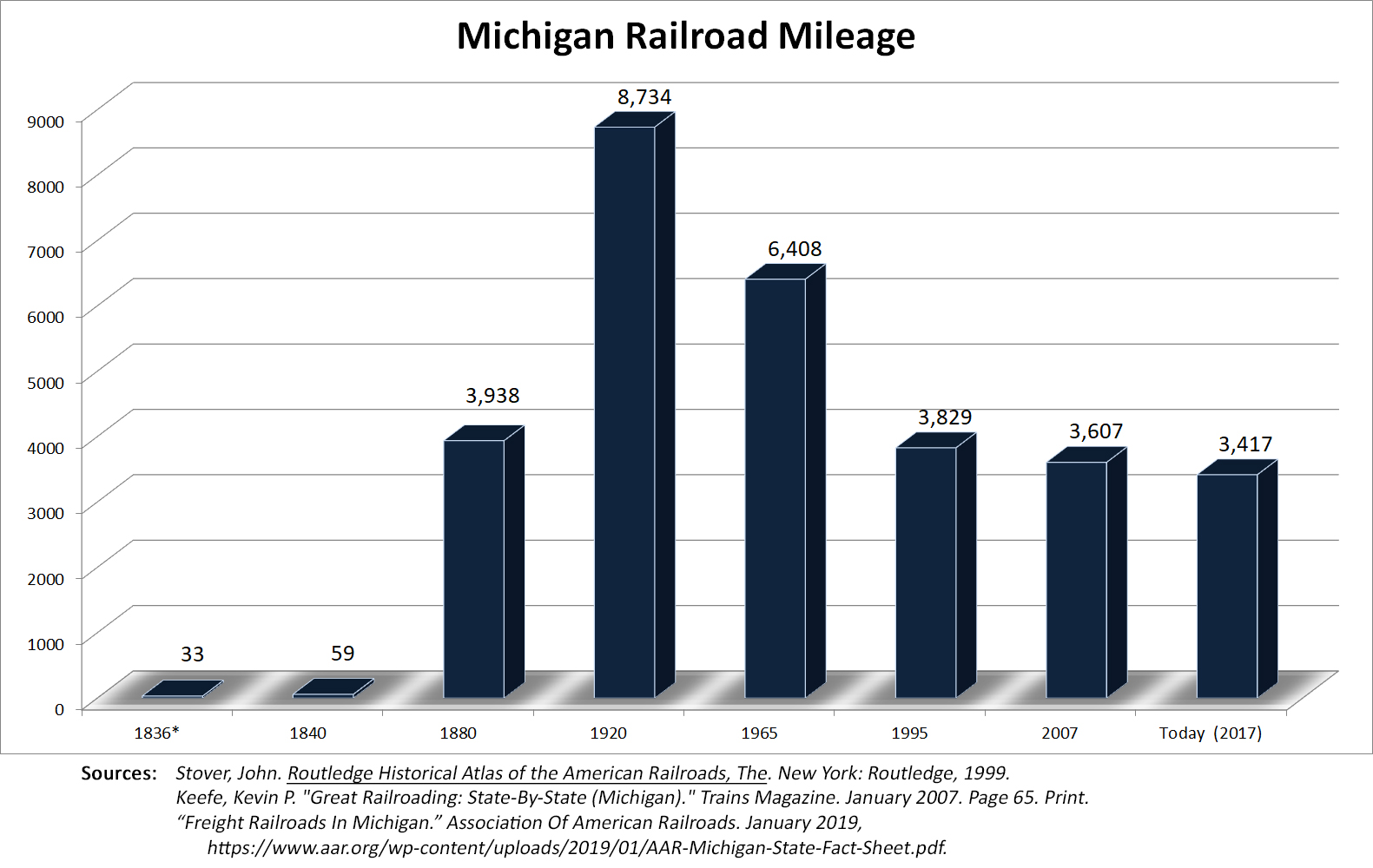- Home ›
- The States ›
- Michigan
Michigan Railroads: Map, History, Abandoned Lines
Last revised: September 6, 2024
By: Adam Burns
Michigan has been known for a number of things over its
170+ year history with railroads, from iron ore and timber products to automotive parts
and merchandise.
For decades, and until the 1970s, the state also witnessed significant carfloat operations due to its location along the lakes (notably at Ludington).
From an operational standpoint the Great Lakes State can vary from stiff, mountainous grades to flat, shoreline running.
History
If you were able to see the state's railroads in action prior to the 1980s it was quite an interesting affair with a wide and diverse variety of operations.
For many, the through lines running along the state's southern periphery are the most well-known, on their way to either Chicago, Detroit, or via southern Ontario.
In any event, the state is also home to the inventor of the historic Shay locomotive, Ephraim Shay, which built his first prototype in 1877.
Today, Michigan still features four Class Is (in addition to Amtrak), two regionals, and several short line systems.
Photos
 A pair of handsome Pennsylvania F7's, led by #9808, appear to be carrying out switching chores on the former Grand Rapids & Indiana at Mackinaw City, Michigan in February, 1964. Today, the right-of-way is a trail. P.D. Luster, Jr. photo. American-Rails.com collection.
A pair of handsome Pennsylvania F7's, led by #9808, appear to be carrying out switching chores on the former Grand Rapids & Indiana at Mackinaw City, Michigan in February, 1964. Today, the right-of-way is a trail. P.D. Luster, Jr. photo. American-Rails.com collection.Michigan railroads date back to 1836 when the little Erie & Kalamazoo Railroad finished its line connecting Adrian, Michigan and Port Lawrence, Ohio (what is today Toledo), a distance of nearly 40 miles (the line officially opened on November 2nd).
The history of the railroad dated as far back as 1832 although it was not officially chartered until April 22, 1833. While the E&K began as a horse-powered operation it switched to steam power by 1837, a year after begin services.
The railroad eventually became part of the large Lake Shore & Michigan Southern Railway, a massive system for its time, formed through smaller lines like the E&K in 1869.
It would stretch from Buffalo, through northern Ohio, southern Michigan, northern Indiana and also reached Chicago.
In 1914 it became an important part of the New York Central System. In the succeeding years Michigan would be home to a number of well remembered railroads which included the Michigan Central, Grand Trunk Western and many others.
Statistics
During the state's height it was a railfan's paradise; you could catch New York Central streamliners heading to and from Detroit, head west to Lake Michigan or north to Lake Superior and enjoy unique car ferry operations, or even head up to the U.P. and catch ore trains along the Milwaukee Road and Chicago & North Western.
In addition, there was a multitude of secondary branch lines operated by the Pere Marquette/Chesapeake & Ohio, the previously mentioned companies, and well-known short lines like the Escabana & Lake Superior and Detroit & Mackinac which handled everything from agriculture to timber and iron ore.
State Map
Alas, much of this business was either lost to trucks or simply dried up by the mid 20th century. In addition, airlines pulled away much of the passenger business.
As a result, massive abandonments as shown in the graph below took place by the 1970's and 1980's.
The state map featured above shows most of the rail lines in service across Michigan by the turn of the 20th century. Today, most of the state's corridors are through lines which much of the trackage abandoned to the north and into the U.P.
Current Railroads
- CSX
- Norfolk Southern
- Canadian National
- Canadian Pacific
- Ann Arbor
- Delray Connecting Railroad
- Escanaba & Lake Superior
- Huron & Eastern Railway
- Indiana & Ohio Railway
- Lake States Railway
- Lake Superior & Ishpeming
- Marquette Rail
- Michigan Shore Railroad
- Michigan Southern Railroad
- Mid-Michigan Railroad
- Adrian & Blissfield Rail Road
- Charlotte Southern Railroad
- Detroit Connecting Railroad
- Grand Elk Railroad
- Grand Rapids Eastern Railroad
- Indiana Northeastern Railroad
- Lapeer Industrial Railroad
- Michigan Air-Line Railway
- Saginaw Bay Southern Railway
- West Michigan Railroad
Today, all of these railroads operate just over 3,600 miles of track in the Great Lakes State, which is a just a fraction of Michigan's all-time of 8,734.
The state has lost a staggering 59% of its rail infrastructure since the 1920s and more than 5,000 miles overall.
Abandoned Lines
Michigan has been hit especially hard by abandonments; several through lines have been pulled as well as hundreds of miles of secondary and agricultural corridors.
To date, more than 5,300 miles have been removed. The abandonments have largely been secondary corridors. However, there are notable losses such as:
- Sections of Pennsylvania's Grand Rapids & Indiana Railroad subsidiary that ran from Fort Wayne, Indiana to Mackinaw City.
- Hundreds of miles of the old Michigan Central (New York Central) lines have been removed, particularly in the southcentral regions and the north around Mackinaw City.
- A major route of the Cleveland, Cincinnati, Chicago & St. Louis Railway (the "Big Four"), the longtime New York Central subsidiary, is removed between Jackson, Michigan and Carlisle, Ohio (south of Dayton).
- Several sections of the Lake Shore & Michigan Southern (NYC) have been pulled throughout southcentral Michigan.
- Large sections of the Grand Trunk Western are pulled up west and north of Detroit, as well as in other parts of Michigan.
- Most iron ore lines in the Upper Peninsula have either been removed or severely truncated. These branches were largely serviced by the Milwaukee Road, Soo Line, and Chicago & North Western. In addition, the Copper Range Railroad is gone entirely. Another notable U.P. carrier since shuttered was the Manistique and Lake Superior Railroad.
- Finally, Michigan once contained 981 miles of interurbans at its peak, noted in the book, "The Electric Interurban Railways In America" by George Hilton and John Due. Most were situated around Detroit and were some of the earliest ever put into service. In addition, systems like the Detroit United Railway and Michigan United Railway were some of the best maintained and most modern interurbans in the country. Alas, the fast growth of highways in the state resulted in its interurbans being abandoned quickly with service ending entirely by 1934.
This number is even well above the average of most states, which have seen a decline typically between 45% to 50%. Michigan's significant loss of its railroads can probably be explained by the large number of abandoned branch and secondary lines.
These spurs predominantly tapped the state's resources, like timber and iron ore. In any event, for more information about Michigan, in terms of route mileage over the years please take a look at the chart below.
State Mileage Chart
First Railroad
* Michigan's first railroad put into service was the Erie & Kalamazoo, chartered on April 22, 1833 to connect Port Lawrence (now known as Toledo, Ohio) with the Kalamazoo River via Adrian, Michigan. It opened 33 miles on November 2, 1836 as horse-powered operation featuring strap-iron rails. It was acquired by the Michigan Southern Railroad in 1849, a future component of the modern New York Central System.
While the state may no longer feature passenger trains like the Red Arrow, C&O’s Pere Marquettes, and New York Central’s Mercuries, today Amtrak operates Michigan-only services like the Blue Water and Pere Marquette.
Amtrak also owns its only stretch of trackage outside of the Northeast Corridor in Michigan which is the 97-mile, 110 mph Wolverine Corridor that connects Detroit and Pontiac with Chicago. To learn more about Amtrak's current services in Michigan please click here to visit their website.
 Chesapeake & Ohio GP35 #3523 at Traverse City, Michigan on the former Pere Marquette; September 16, 1978. American-Rails.com collection.
Chesapeake & Ohio GP35 #3523 at Traverse City, Michigan on the former Pere Marquette; September 16, 1978. American-Rails.com collection.Museums
In terms of the state's history it is home to several railroad museums and excursion trains (for instance, Michigan is also home to Pere Marquette #1225, the operational 2-8-4 Berkshire steam locomotive owned by the Steam Railroading Institute and was featured in the Polar Express).
Some of these include the Henry Ford Museum, Michigan Transit Museum, Huckleberry Railroad, Southern Michigan Railroad, and the Adrian & Blissfield Railroad(which also offers excursion train services.
So, whatever your interests might be, Michigan railroads offer a unique experience of Class I, main line operations as well as several local “down by the depot” short lines.
And, if these tire you out after a while be sure and ride one of the state’s several dinner and excursion trains!
Contents
Recent Articles
-
Rio Grande 2-8-2 Locomotives (K-37): Specs, Roster, Photos
Apr 15, 25 12:57 PM
Rio Grande's Class K-37 Mikes were itsdge steamers to enter service in the late 1920s. Today, all but two survive. -
Rio Grande 2-8-2 Locomotives (K-36): Specs, Roster, Photos
Apr 15, 25 11:09 AM
The Rio Grande's K-36 2-8-2s were its last new Mikados purchased for narrow-gauge use. Today, all but one survives. -
Rio Grande 2-8-2 Locomotives (Class K-28): Specs, Roster, Photos
Apr 14, 25 10:24 PM
Rio Grande's Class K-28 Mikados were its newest narrow-gauge steam locomotives since the Mudhens of the early 1900s. Today, three survive.




